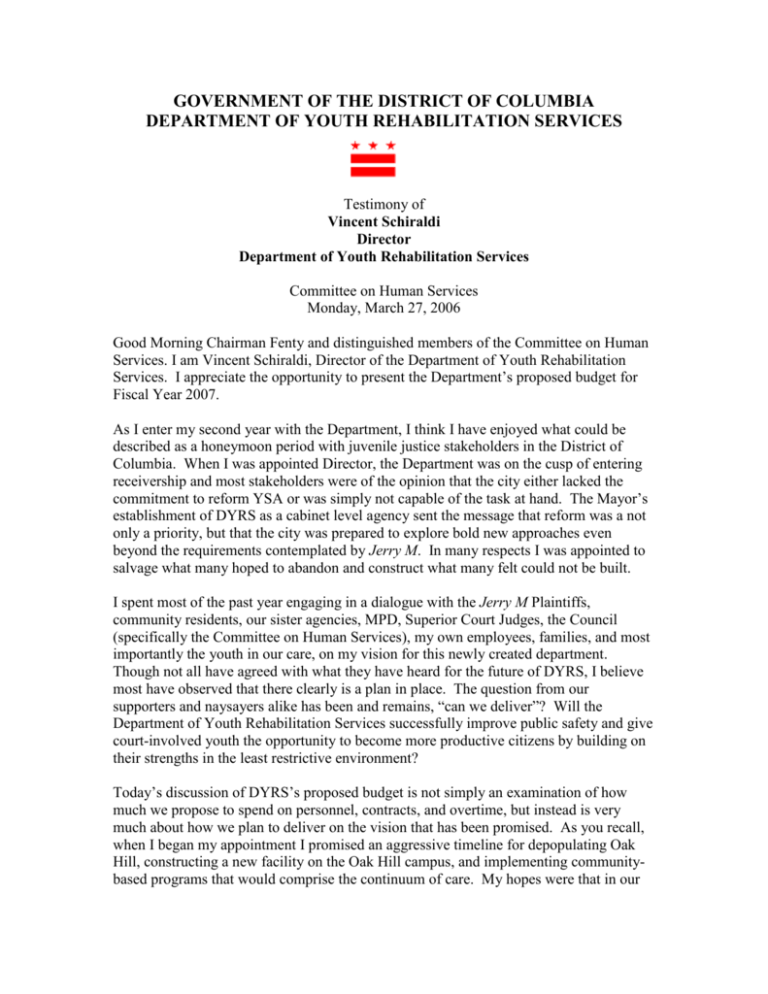government of the district of columbia
advertisement

GOVERNMENT OF THE DISTRICT OF COLUMBIA DEPARTMENT OF YOUTH REHABILITATION SERVICES Testimony of Vincent Schiraldi Director Department of Youth Rehabilitation Services Committee on Human Services Monday, March 27, 2006 Good Morning Chairman Fenty and distinguished members of the Committee on Human Services. I am Vincent Schiraldi, Director of the Department of Youth Rehabilitation Services. I appreciate the opportunity to present the Department’s proposed budget for Fiscal Year 2007. As I enter my second year with the Department, I think I have enjoyed what could be described as a honeymoon period with juvenile justice stakeholders in the District of Columbia. When I was appointed Director, the Department was on the cusp of entering receivership and most stakeholders were of the opinion that the city either lacked the commitment to reform YSA or was simply not capable of the task at hand. The Mayor’s establishment of DYRS as a cabinet level agency sent the message that reform was a not only a priority, but that the city was prepared to explore bold new approaches even beyond the requirements contemplated by Jerry M. In many respects I was appointed to salvage what many hoped to abandon and construct what many felt could not be built. I spent most of the past year engaging in a dialogue with the Jerry M Plaintiffs, community residents, our sister agencies, MPD, Superior Court Judges, the Council (specifically the Committee on Human Services), my own employees, families, and most importantly the youth in our care, on my vision for this newly created department. Though not all have agreed with what they have heard for the future of DYRS, I believe most have observed that there clearly is a plan in place. The question from our supporters and naysayers alike has been and remains, “can we deliver”? Will the Department of Youth Rehabilitation Services successfully improve public safety and give court-involved youth the opportunity to become more productive citizens by building on their strengths in the least restrictive environment? Today’s discussion of DYRS’s proposed budget is not simply an examination of how much we propose to spend on personnel, contracts, and overtime, but instead is very much about how we plan to deliver on the vision that has been promised. As you recall, when I began my appointment I promised an aggressive timeline for depopulating Oak Hill, constructing a new facility on the Oak Hill campus, and implementing communitybased programs that would comprise the continuum of care. My hopes were that in our second year Oak Hill would have significantly fewer youth, we would be well into construction of a new facility, and have several new community-based programs operational. As discussed during the Department’s February oversight hearing, although Oak Hill’s population is significantly lower than when I started, our plans to depopulate Oak Hill have not completely come to fruition and construction of the new facility has been encumbered by burdensome bureaucratic requirements. Thanks to your leadership Councilmember Fenty, passage of the “Oak Hill Construction Streamlining Emergency Amendment Act of 2006” should improve our ability complete construction much sooner than anticipated. While the FY07 budget is in no way a radical departure from the FY06 budget, it does serve as a milestone in our efforts close the book on operating a deficit-based system focused on secure custody, as we make strides towards a system that is driven by an emphasis on positive youth development. The FY07 budget reflects our new direction, but also reflects our commitment to comply with Jerry M requirements and move closer to successfully fulfilling all consent decree mandates. The proposed Fiscal Year 2007 budget for the DYRS is $67,209,956. This represents an increase of $5,883,227 from the fiscal year 2006 budget. The proposed budget includes $66,555,366 in local funds, an increase of $7,465,138. The proposed budget supports a staffing compliment of 667 FTEs, an increase of 96 FTES from FY 2006. During my last three appearances before the Committee on Human Services I have focused my testimony on the status of developing the continuum of care and construction of the new facility at Oak Hill. I believe the Committee is well aware of the programs that we have implemented, new programming we are working to put in place, and the concept for design of the new facility at Oak Hill. Today, I would like to focus on challenges the Department is facing in our efforts to depopulate our secure facilities and enhance our community-based continuum. When I was confirmed as Director I invested my first few months into aggressively reducing the population at Oak Hill. Within a matter of months we were able close several units that were in greatest need of repair. Unfortunately, as discussed during our recent oversight hearing, each of the units that we had hoped to close permanently, have been re-opened with the exception of Unit Six, which was also re-opened for a short period but is currently closed. Councilmember Fenty, during the February oversight hearing you asked what it would take to close units at Oak Hill and actually keep them closed. The answer to that question is not resolved by examining how we at DYRS manage our facilities, but instead is a systemic issue that requires us to first examine how many youth we are locking up, and then ask how many of those youth are truly best served by secure confinement. The juvenile justice system is comprised of two populations: detained youth, which are youth who have been arrested and are awaiting trial, and committed youth, which are youth who have gone to trial and been found “involved”. Increases in both populations have greatly impeded our ability to operate a smaller Oak Hill and focus greater attention 2 on the development of community-based programming. Today, I would like to discuss the challenges posed by the increase in each population and the impact on the Department’s implementation of reform efforts. Detained Population Prior to the establishment of DYRS as a cabinet level agency, the former YSA’s primary concern as it related to detained youth was discontinuing the practice of commingling detained youth with committed youth at Oak Hill. It was expected that when the Youth Services Center (YSC) opened in the District commingling would be discontinued because the YSC would be used solely to house detained youth. However, when the YSC opened in 2004 the detained population exceeded the 80 bed capacity of the facility resulting in continued housing of detained youth at Oak Hill. This led some to question why the Youth Services Center was not constructed with greater capacity. Though I was not with the Department when YSC was designed and constructed, I am thankful we did not build a larger facility. The ability to house large numbers of detained youth in large prison-like settings would accomplish little in the way of rehabilitation and would contribute to the overuse of detention which continues to plague our system. The reality is that, during my tenure, secure confinement of detained youth has increased by 23% while the number of juvenile arrests has fallen by 1% and while we have increased funding for model detention alternatives. This increase has required us to focus greater attention on secure custody operation jeopardizing our ability to continue to fund community-based programming. Increased housing of detained youth requires more staff, more overtime and creates longer wait times for shelter care. Our vision for reforming DYRS is premised on the ability to house and serve youth in the least restrictive environment consistent with public safety. Because community-based services were scarce when DYRS was established our early reform plans were geared towards program development. With each program that was implemented there was an expectation that there would be a decrease in the number of youth in locked custody. It would appear that, so far, I have failed to deliver on many of the promises I made when confirmed to reduce the number of youth at Oak Hill, but I think it is important to note that the plan I presented last year did not account for the increase in the number of detained youth that have been referred to us by the courts. Aside from the fact that a detained youth is awaiting trial and a committed youth has already been to trial there is another important distinguishing factor. That factor is who has authority to decide where the child will be placed. When a youth is committed to DYRS, the Department has authority over placement decisions. The Department can decide to place the child in any setting appropriate to meet the needs of the youth and consistent with public safety without seeking permission from the courts. Detained youth on the other hand are placed by the courts who have sole authority over any changes that are made to the child’s placement status. When a child is awaiting trial the court considers a host of factors and then decides where the child should be placed while awaiting trial. In some cases the child is simply sent home with their parents. But there are other cases where the courts believes that sending the child home is not likely to 3 achieve their appearance on their court date, or the youth poses a threat to public safety. In many of those cases the youth is ultimately sent to DYRS. The chart below illustrates the increase in the number of detained youth from June 2005 to March 20th of this year. You’ll notice that in June 2005 the secure population was 139 compared to 156 in March, 2006. Also, notice that on June 23 the securely defined population was 53 youth higher than the 80 bed capacity of YSC which was built to house only detained youth. Securely Detained Youth Population June 23, 2005 vs. March 20, 2006 Secure Detention Pop 160 156 155 150 145 139 140 135 130 June 23, 2005 March 20, 2006 Date The second chart illustrates the average number of detained youth in locked custody since FY 2002. You’ll notice that the number of youth being referred to secure confinement has grown consistently since FY2002 outpacing the increase in juvenile arrests. For example, since FY2004, the average securely detained population has increased by 43%, while the average number of weekly arrests actually dropped last fiscal year, and is up by just 7% over the past two years. Average Juvenile Secure Detention Population FY 2002 - FY 2006 Mean Population 160 145 140 124 120 100 101 96 86 80 60 40 20 0 FY 2002 FY 2003 FY 2004 Fiscal Year 4 FY 2005 FY 2006 An easy explanation of this growth trend would be that detention has grown because juvenile crime has increased. However, if we examine the average number of weekly juvenile arrest for substantially the same time period (FY 2002 – FY 2005) you will see that weekly arrest did increase but not as sharply as the number of youth being confined. These numbers alone don’t reveal enough for us draw any one conclusion about the increased number of detained youth entering secure confinement, but it does dispel any single-minded notion that incarceration is rising as a result of a juvenile crime wave. Average Juvenile Secure Detention Population vs. Average Weekly Juvenile Arrests, FY 2002 - FY 2006 Mean Secure Pop & Average Weekly Arrests 140 125 120 100 102 96 87 80 56 60 49 41 54 40 20 0 FY 2002 FY 2003 FY 2004 FY 2005 Fiscal Year Avg. Secure Detention Pop Avg. Weekly Juvenile Arrests On several occasions I have testified about the Juvenile Detention Alternatives Initiative (JDAI). As you recall the District of Columbia was designated as a JDAI site in June 2005. There are several elements through which JDAI can help DC’s juvenile justice system successfully reduce the detention population consistent with public safety. Three of those are accelerating the processing time for youth awaiting trial, screening youth out of secure detention who don’t need to be locked up, and developing detention alternatives for youth who are diverted from detention but who need additional support and supervision to successfully return to court without being rearrested. DYRS, with the help of the Mayor and Council, have provided support for two well respected programs for youth in the Intensive Third Party Monitoring Program and the Evening Reporting Center which are up and running. Through JDAI, which is co-chaired in DC by Family Court Presiding Judge Josey-Herring and Deputy Mayor Brenda Donald Walker, we are tackling, but have not yet tackled, the issues of diverting youth into detention alternatives and accelerating case processing so youth don’t languish in detention. The success of JDAI will have great impact on our depopulation efforts and enhance our ability to provide quality care of our youth consistent with public safety. JDAI’s impact may not 5 result in great savings, but instead would shift where and what we spend our dollars on, and would improve our efforts to “right size” our juvenile justice system. Through JDAI we are collaboratively searching for answers and alternatives to secure detention. We are joined with our partners at the DC Superior Court, Court Social Services (CSS), the Criminal Justice Coordinating Council (CJCC), the Office of the Attorney General (OAG), the Public Defender Service (PDS), the Metropolitan Police Department (MPD), the Department of Mental Health (DMH) and Child and Family Services Agency (CFSA) to develop alternatives are much more likely to succeed because of the buy-in and support provided by each of the JDAI partners. In January, all of those JDAI partners traveled to Chicago to hear about how their system successfully reduced youth crime and youth failures to appear for court date. To put our observations to work for the District we will have a retreat in April to implement many of the ideas we learned during that trip. While I cannot put a firm timeline on when JDAI will help us reduce the detention population and engage in a best practices approach to detention, I can assure the Committee that all JDAI partners are working hard to achieve success. Committed Population The second challenge is depopulating the committed population at Oak Hill. During the hearing held February I testified about a study that had been conducted by the Annie E. Casey foundation examining committed youth at Oak Hill. The study analyzed youth admitted to Oak Hill between July 1, 2004 and June 30, 2005, and explored four key issues: What are the characteristics of youth committed to Oak Hill? What are the presenting offenses and prior offense history of youth committed to Oak Hill? How long are youth placed at Oak Hill and what are their subsequent placements? Could the number of youth placed in secure custody at Oak Hill be safely reduced? The Casey report highlighted the “edifice complex” that I have spoken about on many occasions. The report broke the population into three tiers based on the severity of charges and number or prior adjudications. During the February hearing I discussed what the report labeled as “tier 3” youth, which were youth committed for misdemeanors, simple possession charges, and lower level felonies, with no or one prior adjudication. Of the 219 youth committed to Oak Hill during the study year, 91 youth (42%), were committed for misdemeanors, drug possession, or lower-level first-offense felonies. It was this group that I committed to reduced during the hearing at Oak Hill. I believe the Committee will be please to know that we are on pace to fulfill my commitment and possibly exceed it. 6 The chart below illustrates the number of prior adjudication for committed youth at Oak Hill during the survey year. You will notice that half of the committed youth had no prior adjudication and nearly 29% had only one prior adjudication. 4 Prior Adjudications 2.7% 3 Prior Adjudications 2.7% 5 Prior Adjudications 0.9% 6+ Prior Adjudications 0.5% 2 Prior Adjudications 14.5% No Prior Adjudications 50.0% 1 Prior Adjudication 28.6% After the hearing in February I tasked my staff to develop a plan to reduce number of Tier 3 youth confined at Oak Hill. Staff then compiled a list of committed youth at OHYC that fit the Tier 3 criteria. The Tier 3 list consisted of 36 youth. After identifying the group that met the Tier 3 criteria, we scheduled a Discharge Review Meeting to begin on March 22nd so that case managers, youth, families and other stakeholders could review the identified youth’s service needs and expedite their placements into appropriate programming. I assigned three staff members to work on this project exclusively. In addition to identifying the youth that met the criteria and scheduling the Discharge Review Meeting these employees worked the case managers that were assigned to these youth. This group provided additional assistance to case managers to expedite the coordination of services. These efforts alone were so effective that we cancelled the Discharge Review Meeting scheduled for March 22nd because we were successfully moving youth prior to that date without additional discharge review. We transitioned nine (9) youth before March 17th and nine (9) more are scheduled to be transitioned from Oak Hill by March 31st. That will effectively move half of the 36 youth I promised by the end of March, well before the July deadline. We have also developed a tracking system to identify newly committed tier 3 youth so that they are not entering the front door while others are moved out the back. The Department of Youth Rehabilitation Services is faced with the unique challenge of leading reform while at the same time trying to build a system that has never truly been 7 constructed in any other jurisdiction in the country. Some would think that DYRS has simply chosen to emulate the “Missouri Model” about which I’ve spoken to this committee on several occasions. But the Missouri approach only focuses on one important aspect of our reforms, the reform of secure care for committed youth. The truth however is that our programming and plans for reform are a combination of many best practices and promising approaches taken from jurisdictions throughout the nation and tailored to the specific needs of District youth, as well as ideas that have percolated up from our staff, community, parents and youth. We work daily to meet Jerry M requirements, while going beyond where Jerry M seeks to take us. Though we are not moving as swiftly as I and many stakeholders would like, make no doubt we are on the move. With continued support from the Mayor, our JDAI partners, the Committee on Human Services, our staff, and the families and youth we serve I believe we are on pace to construct a model system that will invite emulation. I respectfully submit the Department’s Fiscal Year 2007 budget and urge the Committee’s support. I will answer any questions you may have at this time. 8






